Meet the Chef Turning a Tiny Town in Maine Into the Next Big Dining Destination
Dreamy and remote, Deer Isle is home to some seriously good eating — thanks to one chef's vision.
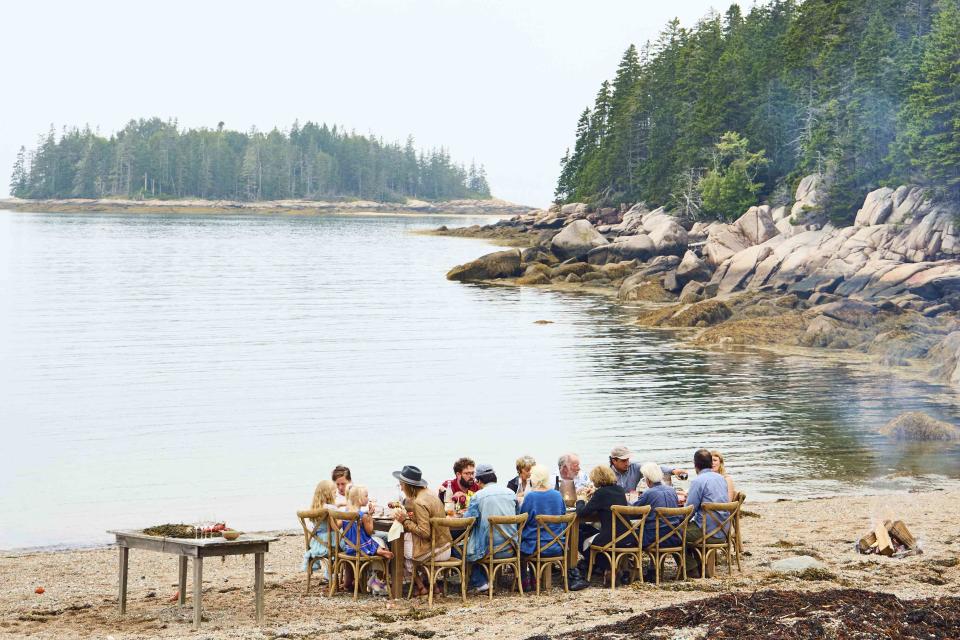
William Hereford
Chef Devin Finigan focuses on local Maine ingredients at her restaurant, Aragosta—and she invites the friends who provide them over for a cookout by the water.“This Isle is like Avalon,” John Steinbeck wrote of Deer Isle, Maine, in his road-trip classic, Travels with Charley. “It must disappear when you are not there.”
You cannot help but feel a similar sense of magic and mystery as you make your way over the wispy, thin bridge that tethers Deer Isle to Maine’s Blue Hill Peninsula. With its deep evergreen forests, mossy trails, rock-bound coves, and wild blueberry patches, Deer Isle feels like the place you try to hold on to in the moments when dreams melt into day. On the island’s western shore, Aragosta, Devin Finigan’s restaurant, nestles into Goose Cove. Bookended by pine forests at either end of the sandy crescent that rims the cove, and just inland from the dunes covered with beach plums and wild mustard, Aragosta’s light-filled dining room offers a vista of sky and silvery sea, cleaved, from time to time, by the wake of a fishing boat.
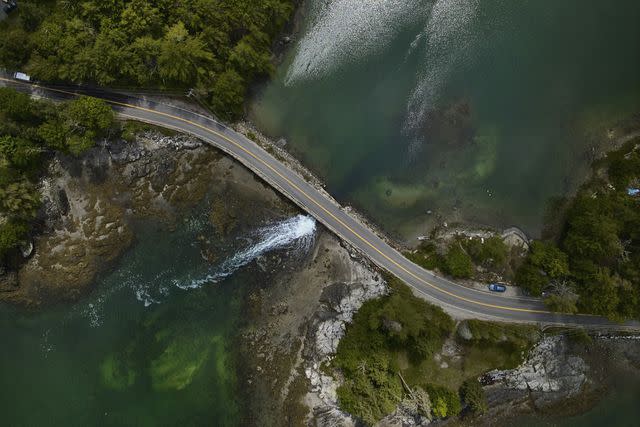
William Hereford
An aerial view of a winding road on Maine’s Blue Hill PeninsulaAfter Labor Day, the summer crowds thin out, and the city folk start to make their way south. The first leaves turn, and you can feel the island settle into a more relaxed pace. Activity will tick up again for a few weeks when autumn briefly blazes among the birches and maples, but that first quiet week, just after Labor Day last year, provided an opportunity for Finigan to host a cookout on the beach for the farmers, fishers, foragers, and artists who have helped make Aragosta a singular dining destination where every plate features Maine ingredients. On the menu for the party: lobsters and steamers baked in a sandy beachfront pit, mussels and fennel on grilled sourdough slathered with saffron aioli, a salad of corn and tomatoes blistered over hot coals, scorched baby vegetables tossed in a powerhouse dressing of fish sauce caramel and maple syrup, and crisped creamy Maine potatoes in bagna cauda. For dessert, a shortcake topped with charred strawberries and lavender whipped cream reflected Finigan’s signature use of flowers in her cuisine.
It’s been 20 years since Finigan dropped out of Savannah College of Art and Design to tag along with her sister Melanie, who was headed to the Haystack Mountain School of Crafts on Deer Isle to study art. “I didn’t arrive with a plan to put down roots here,” Finigan recalls, “but then I fell in love with a Deer Isle lobsterman. We got married, and I’ve lived and worked here ever since.” To make ends meet, Finigan drew on the experience of her teenage years in Vermont, when she’d worked in an inn where her father was a chef. Through a series of local restaurant stints, she cooked her way up the culinary ladder from muffin baker and pancake flipper to chef in her own restaurant, the first version of Aragosta, in Stonington, Deer Isle’s principal community.
Related: An Abundance of Incredible Food Surrounds Acadia National Park
Along the way, she evolved a distinctive cooking style that’s hyperlocal in its sourcing and international in its influences. Cooking for culinary tourists in Tuscany, she acquired a firm grounding in Tuscan food and ingredients. In Spain, working at the Michelin-starred Maca de Castro on Mallorca, she learned how to create menus featuring a wide range of local seafood. Before opening the first incarnation of Aragosta, she spent time during the off-season at Per Se and Blue Hill at Stone Barns, both in New York. Finally, while in the midst of renovating the beachfront campus that became Aragosta’s new home, she spent four weeks at SingleThread in Healdsburg, California, where she immersed herself in the art of wood-fire cooking and the use of Japanese ingredients. Although Finigan has yet to travel to Asia (it’s next on her list), anyone dining at Aragosta will note the Japanese and Korean influences in her recipes. This makes sense: Coastal Maine, like much of Korea and Japan, is a temperate, ocean-facing region with abundant seafood. Finigan’s use of umami-enhancing seaweed and intensely flavorful condiments such as gochujang feels like a natural evolution.
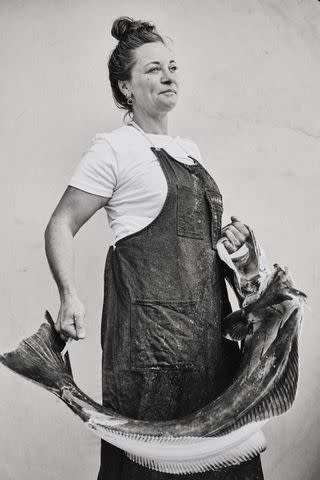
William Hereford
Chef Devin Finigan focuses on local Maine ingredients, like the halibut pictured here, at her Deer Isle restaurant, Aragosta.Finigan also has a lifelong love of gardening, inherited from her mother. Within a few years of her arrival, she was certified as a Maine Master Gardener; some of the most beautiful gardens on Deer Isle are her designs. “In those early years,” Finigan recalls, “I didn’t even have a car, so I would bike between my restaurant and gardening jobs.” This passion is on view everywhere on Aragosta’s 21-acre property, and when Finigan isn’t in the restaurant, she can usually be found in her gardens. She grows flowers for the dining room and edible flowers and herbs for her recipes. She’s also planted an apple orchard and built an apiary, the latter both for its honey and as a home base for the on-site pollinators of everything that grows here.
Despite Maine’s relatively short growing season — or perhaps because of it — local farmers bend their efforts toward extracting maximum flavor from their gardens and orchards. They owe much to the pioneering work of Eliot Coleman, widely recognized as one of the fathers of modern organic gardening, who owns Four Season Farm in nearby Harborside along with his wife, Barbara Damrosch. For Coleman, as well as for the other local farmers that Finigan relies upon, powerful and complex flavors are paramount.
Finigan’s other source of inspiration is the sea. Stonington is Maine’s leading lobster port, and she has developed long and deep relationships with Deer Isle’s intrepid seafarers, who wrest their living from the ocean. There is halibut in the spring and lobsters from spring through fall; there are scallops and mussels, too, which Finigan often serves in what she calls her “tidal broth,” a deeply savory lobster stock that’s combined with dashi. She also cures and smokes mackerel for her North Atlantic version of a Caesar salad dressing. And there are always oysters, lots of them, served throughout the summer with endless varieties of mignonettes — some with strawberries; some with dulse, a type of seaweed; and others with blueberries, apples, and bacon.
On the day of the lobster bake last September, sweet snap peas were at their snappiest and tomatoes at their ripest, and the corn was crunchy and sweet. The day was overcast, the sky a pewter gray, but the low-hanging clouds did no more than threaten as Finigan and her crew dug a pit in the sand and built a roaring fire on the beach. Then, following a time-honored Maine tradition, they covered the blaze with rocks, laid a blanket of wet seaweed on top, placed the lobsters on the seaweed, then layered more seaweed and steamer clams on top of that, and covered it all with wet burlap. A heady, briny aroma wafted over the scene as the guests arrived and were greeted with a cocktail of gin infused with strawberries and a syrup that was surprisingly, but deliciously, flavored with local seaweed.
Related: Where to Taste New England's Wave of Eco-Friendly Seafood
As often happens in small communities, everyone knows one another, but rarely do they ever get a chance to put aside their daily chores in the fields and on the sea to gather together and sit down at a table to enjoy the fruits of their labors. The long table on the pristine beach, the smoke of the cooking fires, the low music of the incoming tide as it lapped the shore — it was a tableau of an idealized Maine, straight out of an Andrew Wyeth painting. As if in recognition of the specialness of the day, the brooding clouds bided their time until the meal was over, the guests had departed, and the cleanup had finished, at which point a steady rain lowered the curtain on the quiet beach.
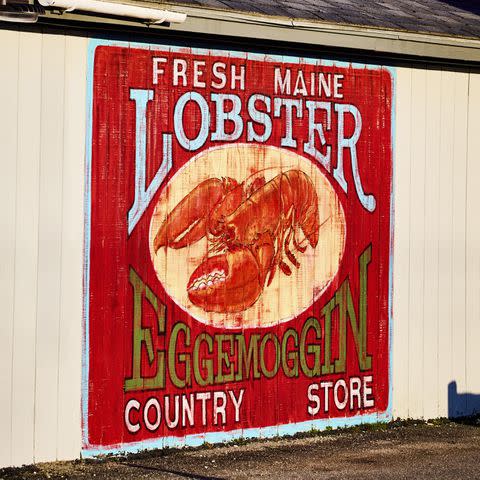
William Hereford
Eggemoggin Country Store in SargentvilleWhere to go and what to do in Deer Isle, Maine
Winding country roads, picturesque farms and houses, seaside and forest rambles, scenic views everywhere — that’s Deer Isle and the Blue Hill Peninsula.
Aragosta
The best way to enjoy Devin Finigan’s extraordinary restaurant Aragosta is to stay in one of the nine cottages on the property. They are simply and tastefully appointed, with views of the bay and the forest. There is also a lovely walk from the Aragosta property along a forest trail that leads to Barred Island. Book early — they fill up fast.
Good Tide Tours
With its flotilla of fishing boats, the town of Stonington is the largest lobster port in Maine; it’s also a thoroughly charming village of clapboard homes and small shops. During the summer season, don’t miss the farmers market. If you’d like a trip on the water, Good Tide Tours plies the local seas in an old-time lobster boat with Captain Walker Collin at the helm.
Haystack Mountain School of Crafts
Haystack Mountain School of Crafts’ wooden complex is one of the 25 most significant works of postwar architecture, according to The New York Times. Artisans working in ceramics, fabrics, metal, wood, and other media come for workshops and residencies, but even if you are not a craftsperson, there are tours, studio visits, and auctions.
44 North Coffee
At 44 North Coffee in the village of Deer Isle, you’ll find custom-roasted drip coffee and pastries from a different local bakery every day.
Bagaduce Lunch
No trip to coastal Maine is complete without some fried clams, lobster rolls, french fries, and coleslaw. Bagaduce Lunch, on the Blue Hill Peninsula in Penobscot, is perched above tidal narrows next to the Bagaduce River. The menu hasn’t changed much since opening day in 1946.
Tinder Hearth
Tinder Hearth, a bakery by day and pizzeria by night, is a relative newcomer. Situated in a picturesque old barn with a picnic grove for outdoor dining, this Brooksville spot turns out pizzas that are as good as any you will find in a big-city food capital. From Tuesdays to Fridays during the summer, Abby Barrows offers her oysters on the half shell.
Caterpillar Hill
For great views, take a short hike up Caterpillar Hill for its overlook of Penobscot Bay. You will pass it as you make your way to Aragosta. The bay lies to your right; on your left is a meadow where glaciers deposited white and gray boulders to scenic effect.
Make Devin Finigan’s lobster bake menu
Lobster and Littleneck Clam Bake
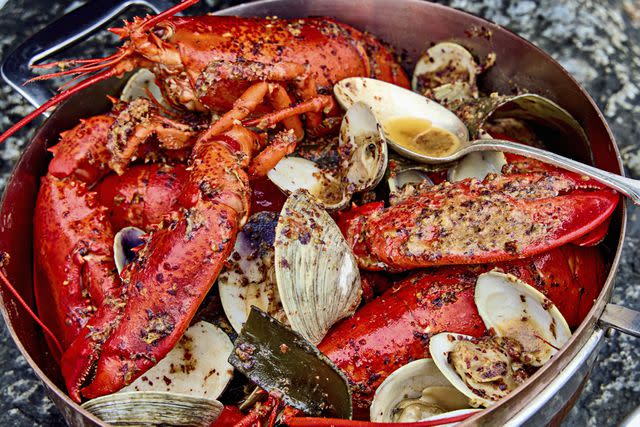
William Hereford
Finigan serves lobsters and clams with butter flavored with Aleppo pepper and dulse, a seaweed that grows in Maine waters. This recipe comes together on the stovetop, but we have tips for how to make it on the beach, too.
Mussels and Fennel on Grilled Sourdough with Saffron and Garlic Aioli
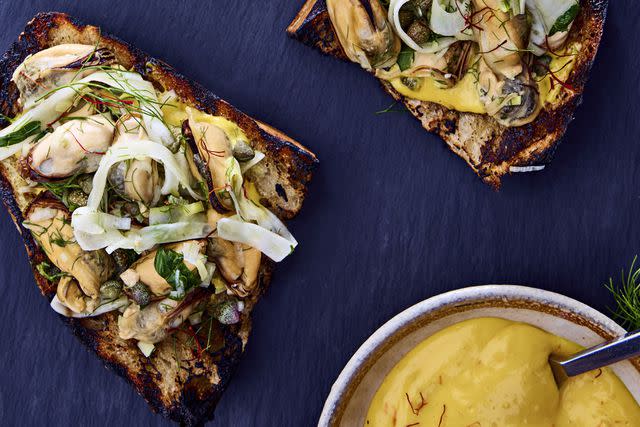
William Hereford
A cross between bruschetta and salad, this innovative starter features mussels steamed in an anise-scented wine broth made with fennel stalks and fronds. Finigan serves the shelled mussels, shaved fennel, and fried caper salad on grilled toasts slathered with saffron aioli.
Smashed Potatoes with Bagna Cauda
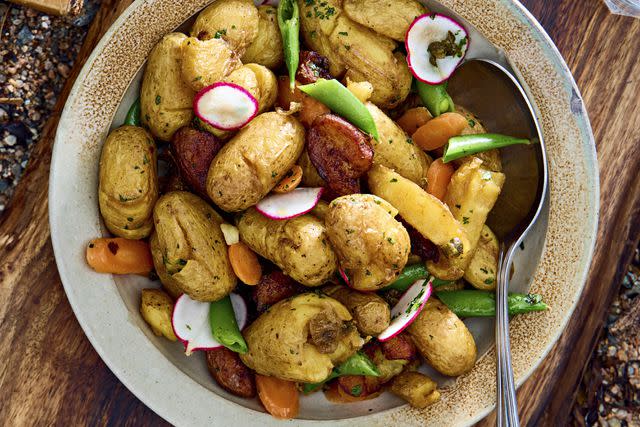
William Hereford
Anchovy-infused oil gives an umami punch to smashed roasted potatoes. The potatoes’ mild, fluffy interior soaks up the warm, flavorful oil, which also dresses the refreshing garnish of crisp-tender sugar snap peas, carrots, and radishes. Fried capers add a satisfying, salty pop to the dish.
Grilled Corn Salad with Blistered Tomato Vinaigrette

William Hereford
Grilling vegetables to a crisp-tender state with a little char is half of the equation for Finigan’s summertime salad. The other half is her smoky tomato vinaigrette, a tangy-sweet sauce that dresses the grilled corn, garlic scapes, cherry tomatoes, and crunchy cucumber and bell pepper.
Grilled Baby Vegetables with Fish Sauce Caramel
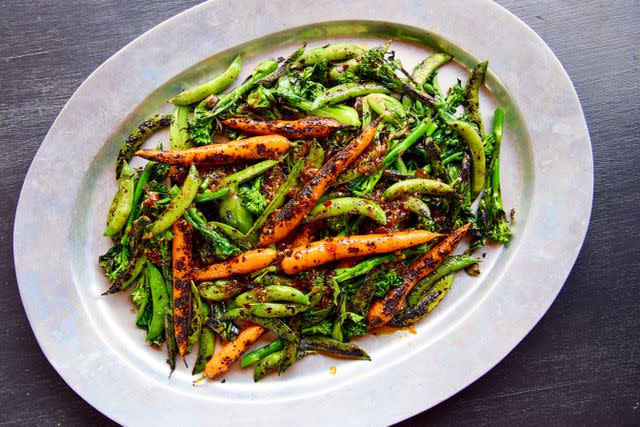
William Hereford
Finigan’s savory fish sauce caramel takes crudités to the next level with a sweet and pungent sauce that is easy to pull off at home. Finigan develops the sauce’s umami notes by cooking brown sugar and fish sauce into a thick syrup that’s infused with onions, garlic, and fresh ginger.
Grilled Strawberry Shortcakes
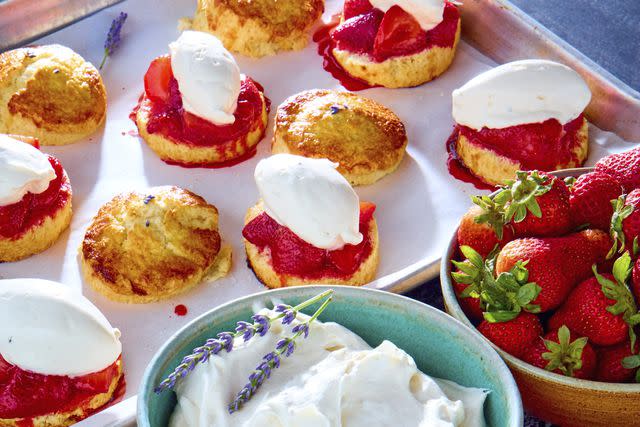
William Hereford
Buttery, tender, and ultra-fluffy, these sweet, lemony biscuits are a delightful foundation for this strawberry dessert. During peak season, strawberries need very little to shine, but Finigan pushes the berries’ flavor further by cooking them on the grill to intensify their already vibrant notes.
For more Food & Wine news, make sure to sign up for our newsletter!
Read the original article on Food & Wine.


